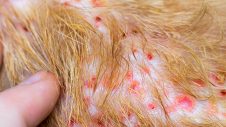What is atopy?
Atopy is an allergic reaction to airborne pollens or particles from grass, trees, dust, cleaning products, or mould. Treatment for atopy involves a course of hyposensitisation injections. To diagnose atopy, a blood or intradermal skin test is required. The most common clinical sign is itching around the muzzle, eyes, ear, armpits, groin, and paws. Some dogs may have recurrent ear infections. As a result of chewing, licking, rubbing and scratching, the skin becomes inflamed and is prone to secondary infections with bacteria and yeast. In dogs with chronic disease, there is hair loss and the skin often becomes thickened, scaly, and black. The coat may feel greasy or have an offensive odour.
How is it diagnosed?
Atopy is diagnosed by performing either a blood test or an intradermal skin test on your dog. This involves testing the dogs antibody levels or reaction to relevant grass, weed and tree pollens, mould spores and housedust. Many drugs including antihistamines and corticosteroids affect the skin test. As all cortisone injections, tablets, lotions and eye and eardrops interfere with the intradermal skin test, it is important that your pet is withdrawn from treatment prior to testing.
How can atopy be treated?
There are several ways that atopy can be managed in order to keep your dog comfortable. Therapy can involve a combination of these alternatives:
Avoidance
Unfortunately, avoidance of grass, weeds, pollen and housedust is virtually impossible. These substances are airborne and in the case of pollens, may travel considerable distances. In some instances, dogs with housedust allergy may benefit from being kept outdoors.
Hyposensitisation
This involves desensitising your pet to things that it is allergic to through a course of injections with purified extracts. It is considered the best treatment for atopy in the dog. There is more detail about hyposensitisation in the information sheet. It is important to realise that the improvement with allergy vaccines is gradual, with obvious benefits taking from between two and six months to appear. While some 70% of dogs are considerably helped by allergy vaccines, there are a percentage of dogs (approximately 30%) in which the vaccine is not effective.
Medical therapy
While your dog is receiving an allergy vaccine, or if you have elected not to pursue hyposensitisation, medical therapy is required to control the itching. The most useful agents to control allergy are cortisone-based drugs. Unfortunately, these can be associated with undesirable side effects. Common side effects included increased thirst, urination and appetite, weight gain and panting. In the long term, cortisone can be associated with infections, liver disease, pancreatitis, and gastrointestinal ulceration. Therefore, they aren’t ideal for long-term term usage. Other medical options include antihistamines and fatty acid supplementation that can help relieve itching.
Topical therapy
Frequent shampooing of your dog will help remove pollen from the coat, surface debris and bacteria and help soothe the skin. We generally recommend that your dog be bathed once a week. Topical cortisone lotion or ointment can be used if only localised areas ie. Paws, ears or around the eyes are affected.
Flea control
It is important to use a thorough flea control in your atopic pet, even if your pet is not allergic to flea bites, the presence of fleas may aggravate his/her underlying allergy. We recommend the use of a topical monthly spot on such as advantage, in conjunction with appropriate environmental flea control measures.

 Greencross Vets
Greencross Vets 










